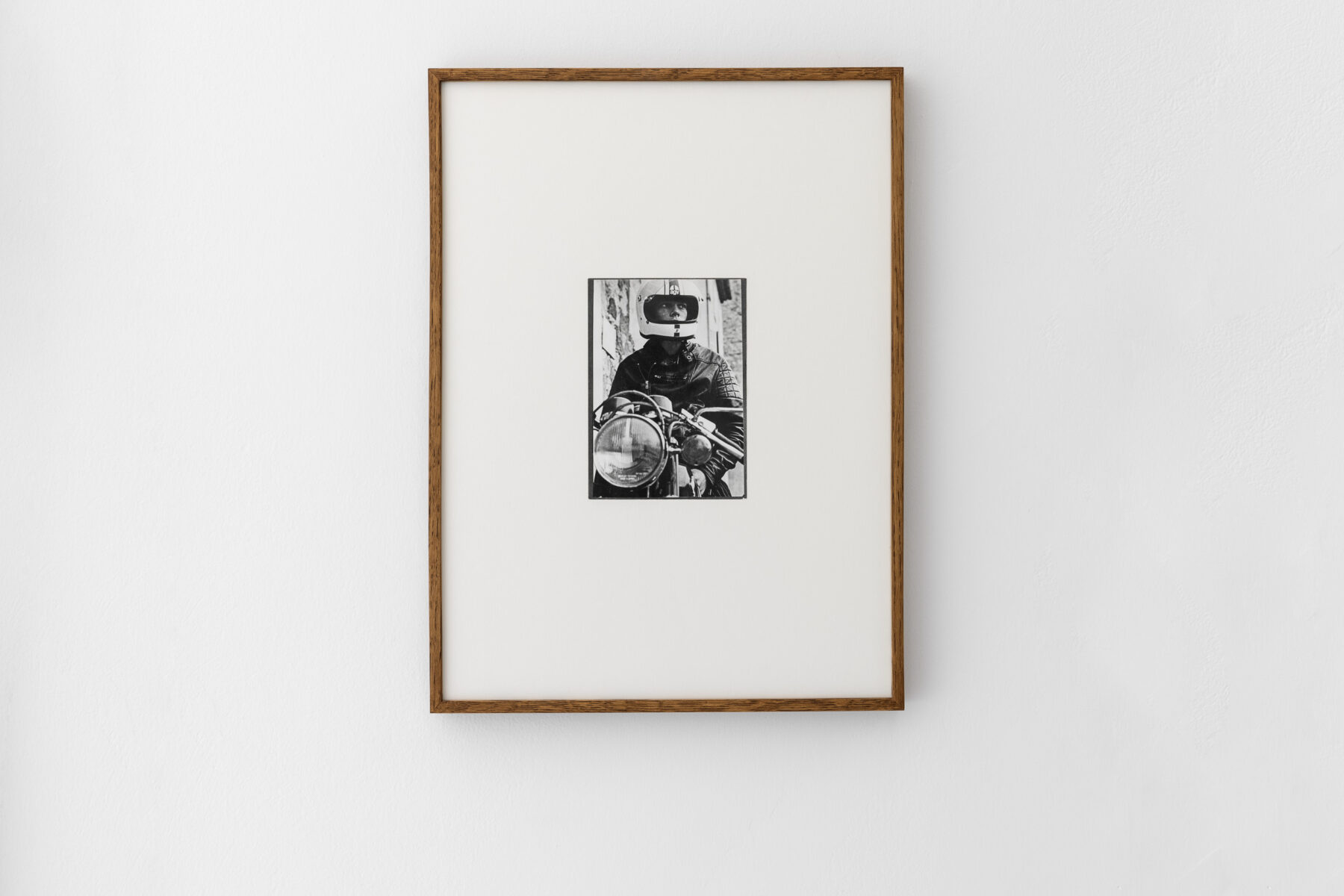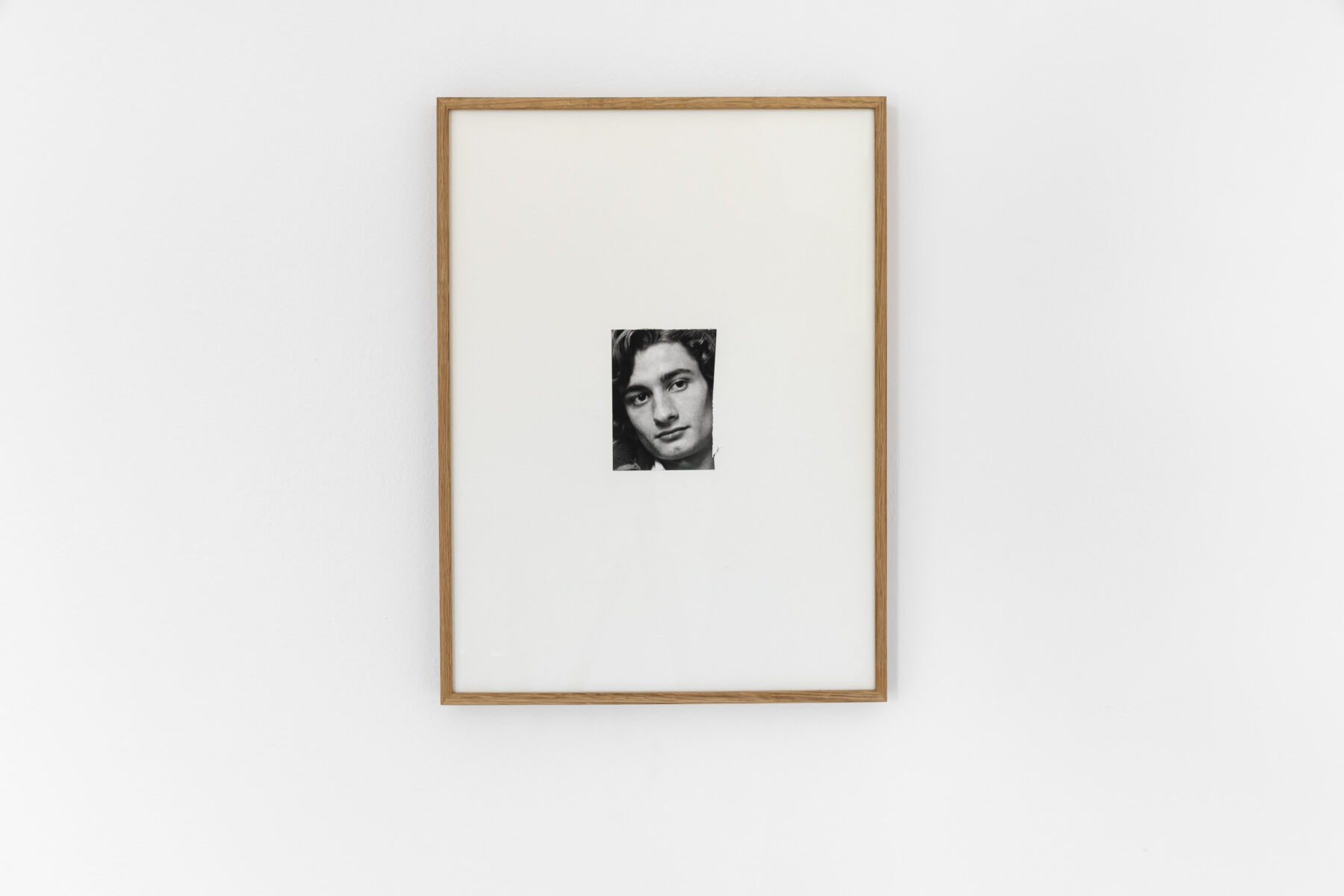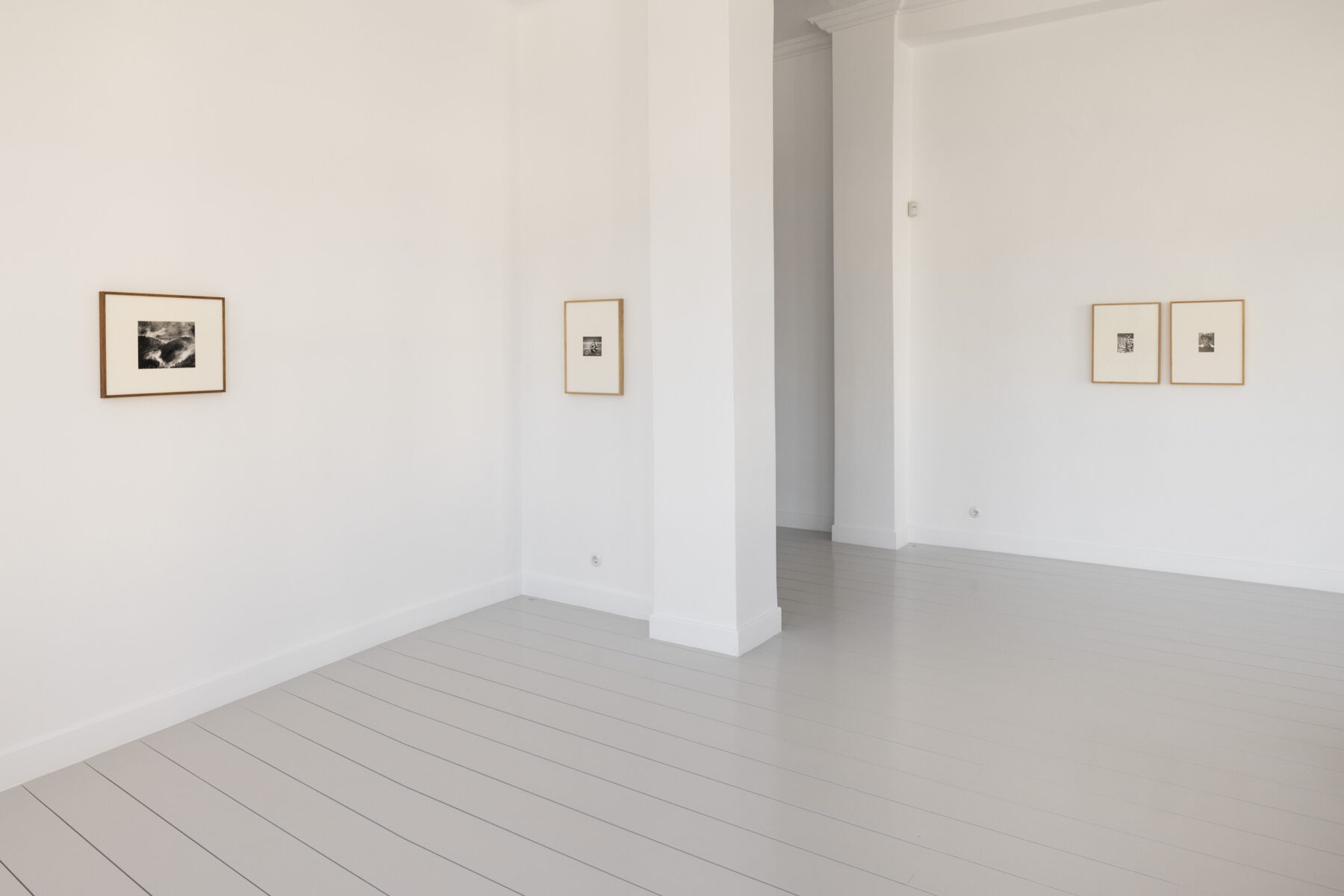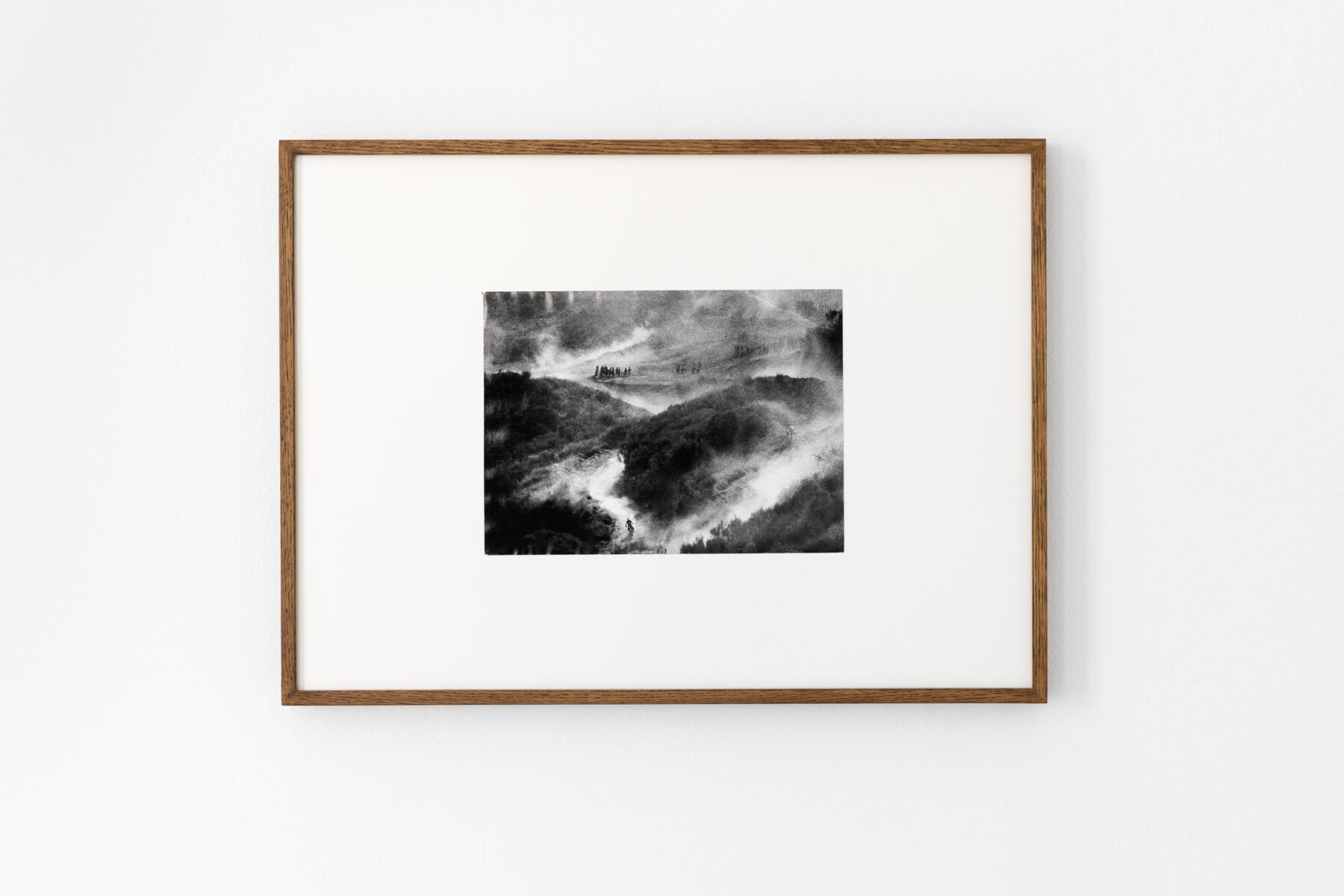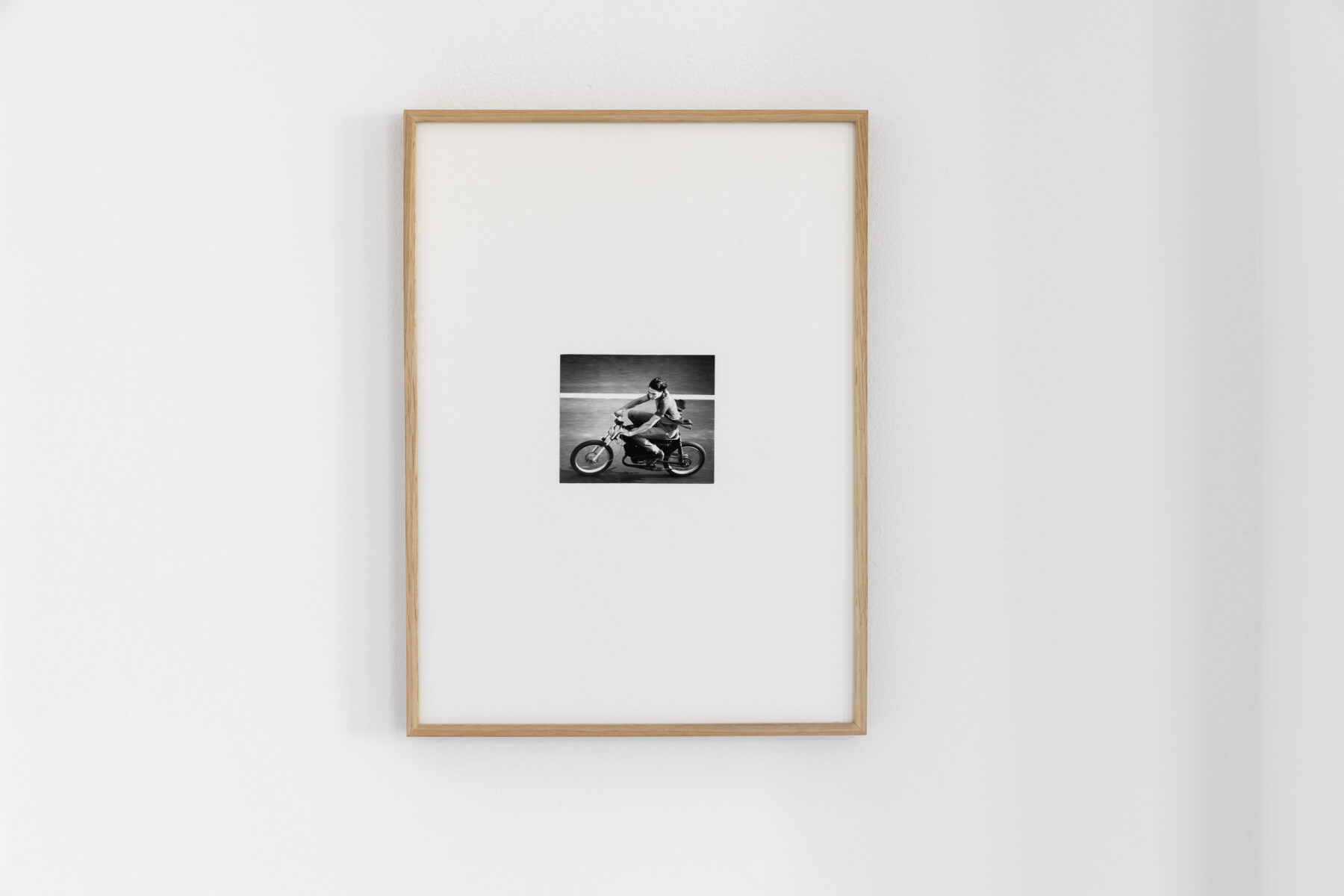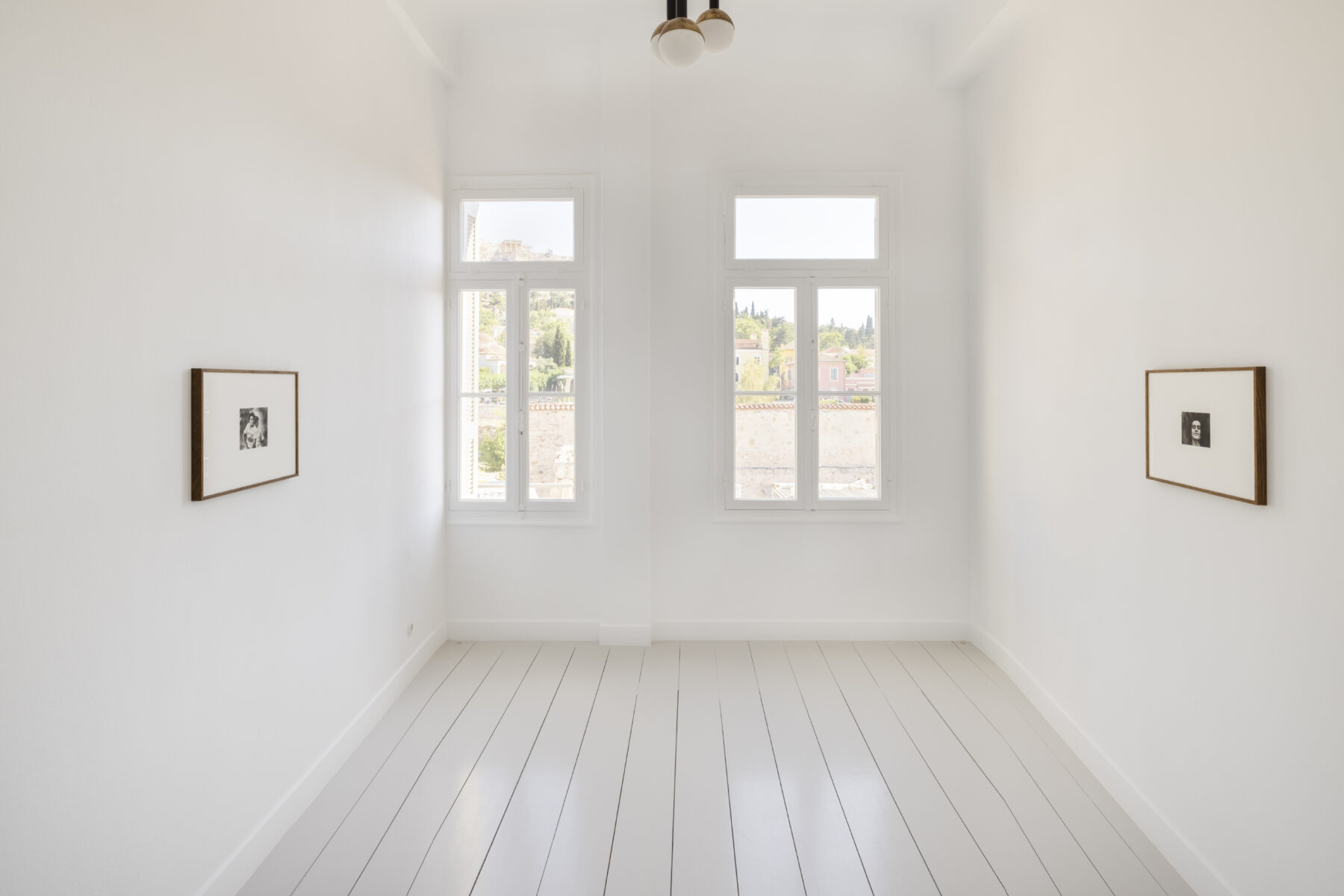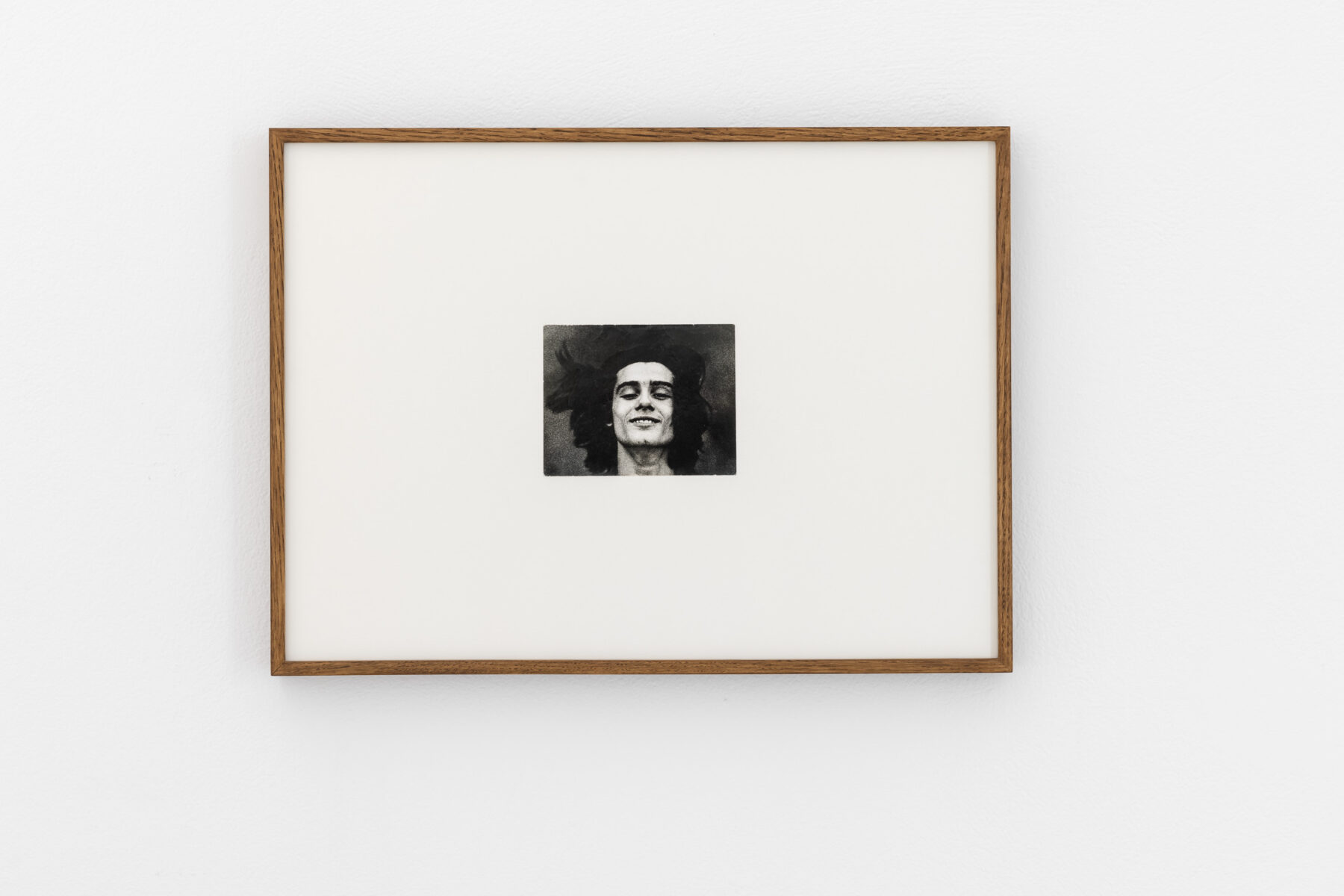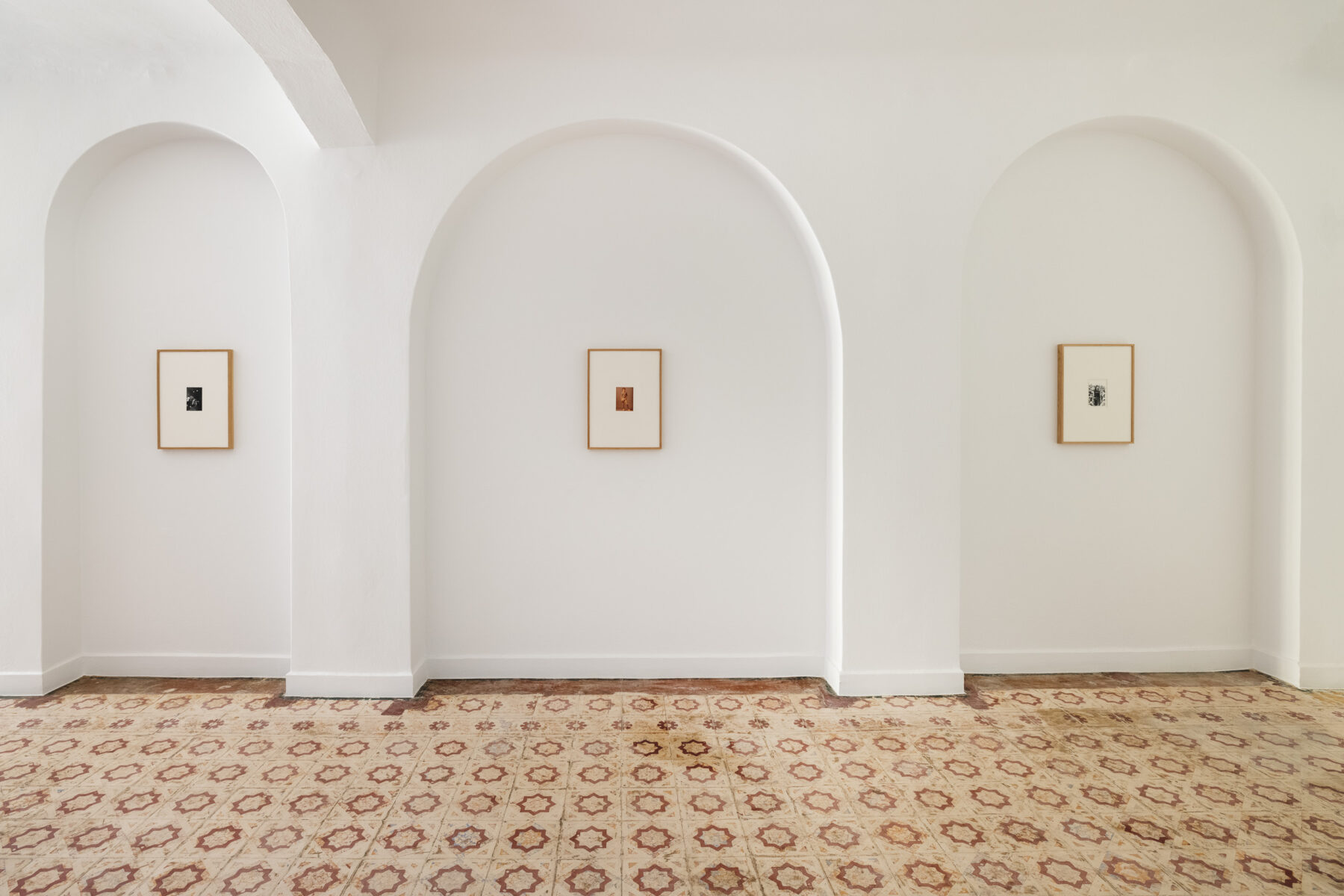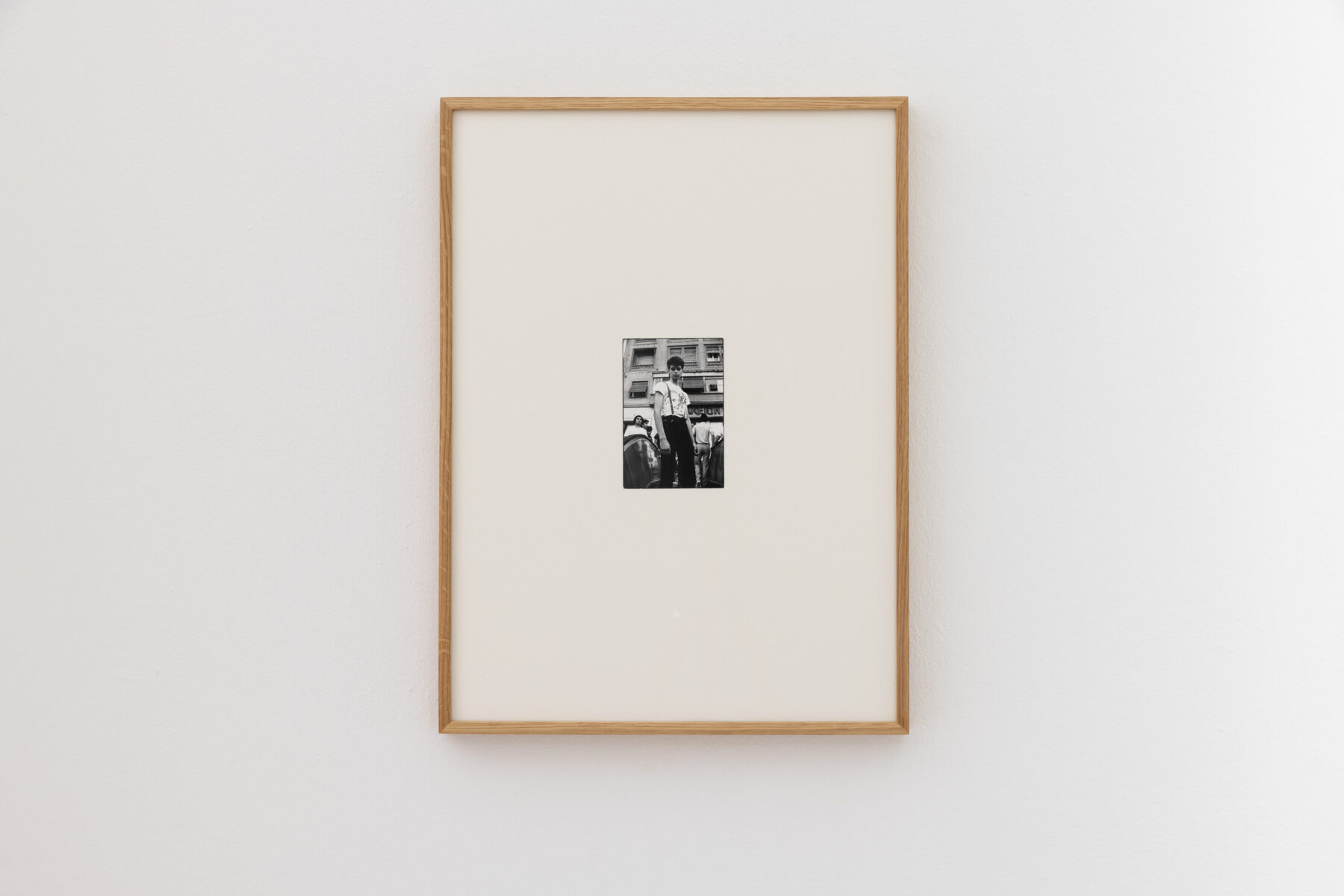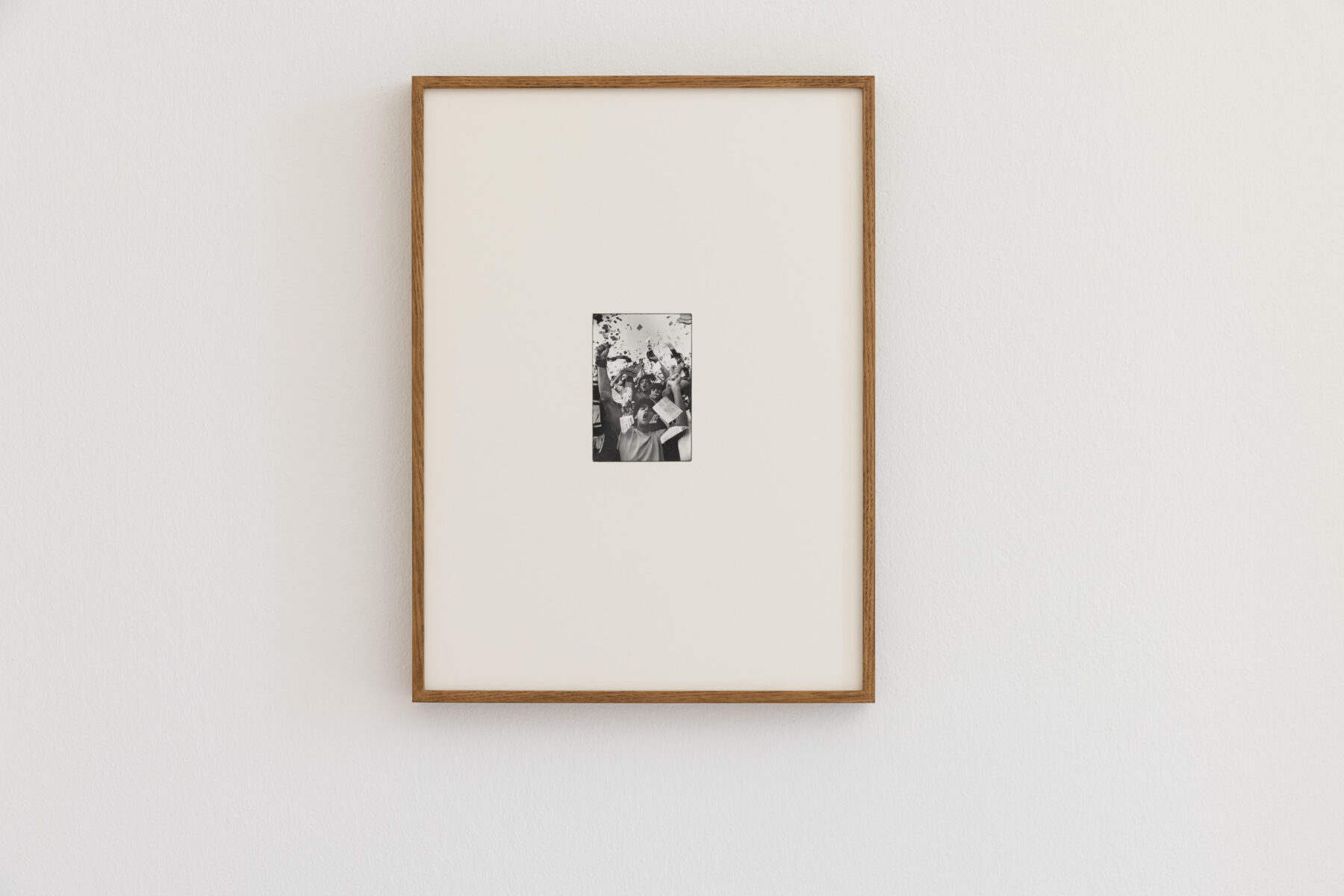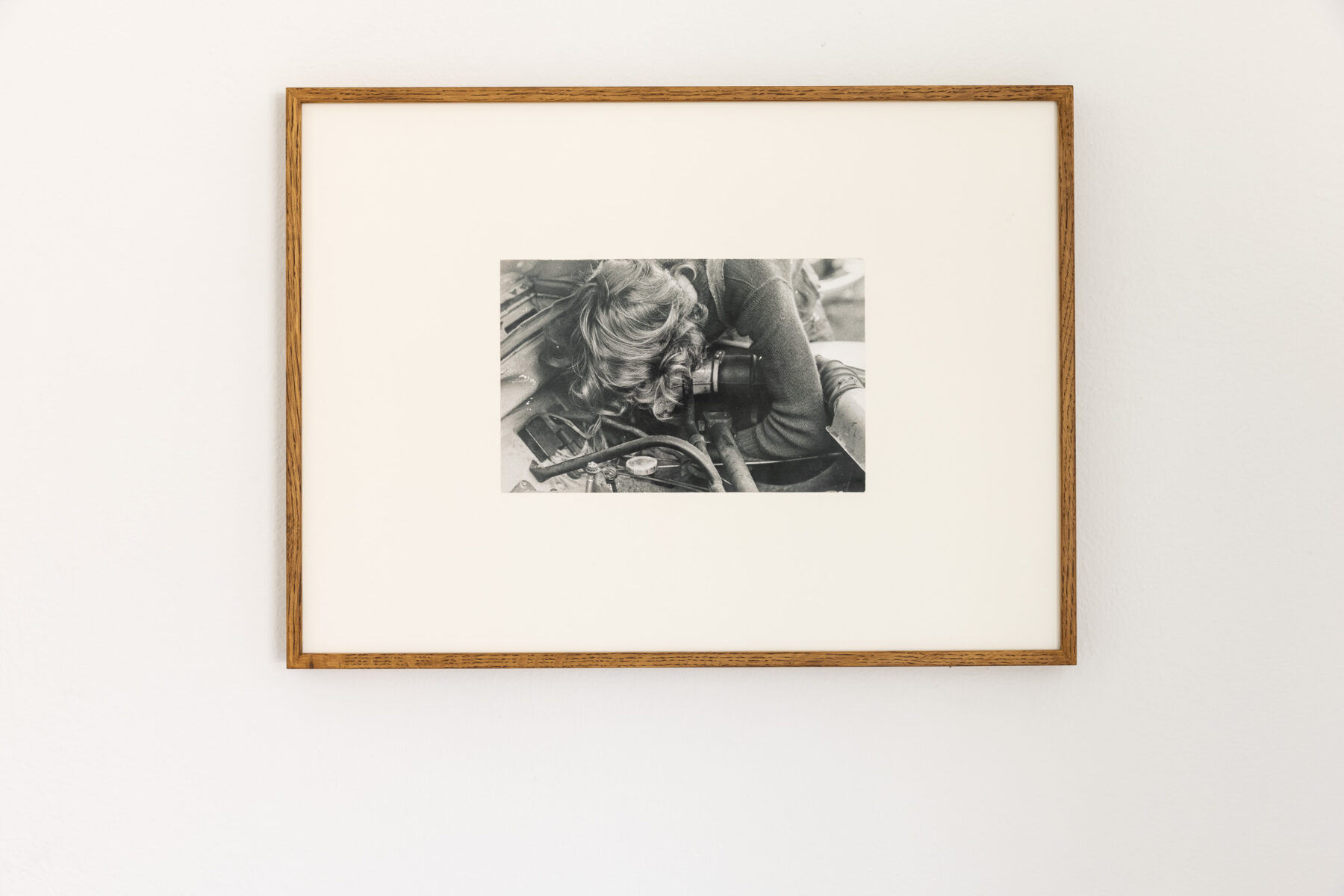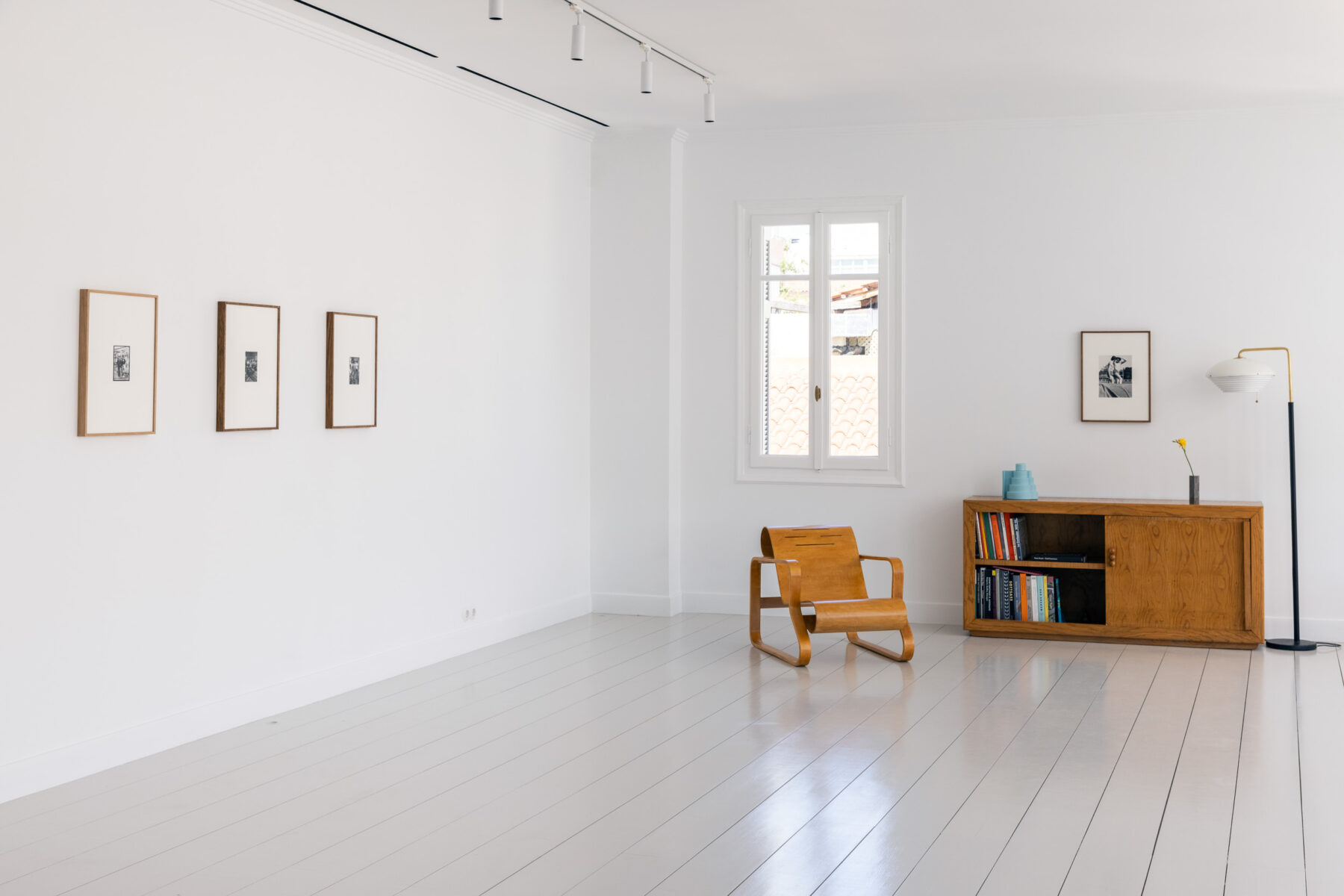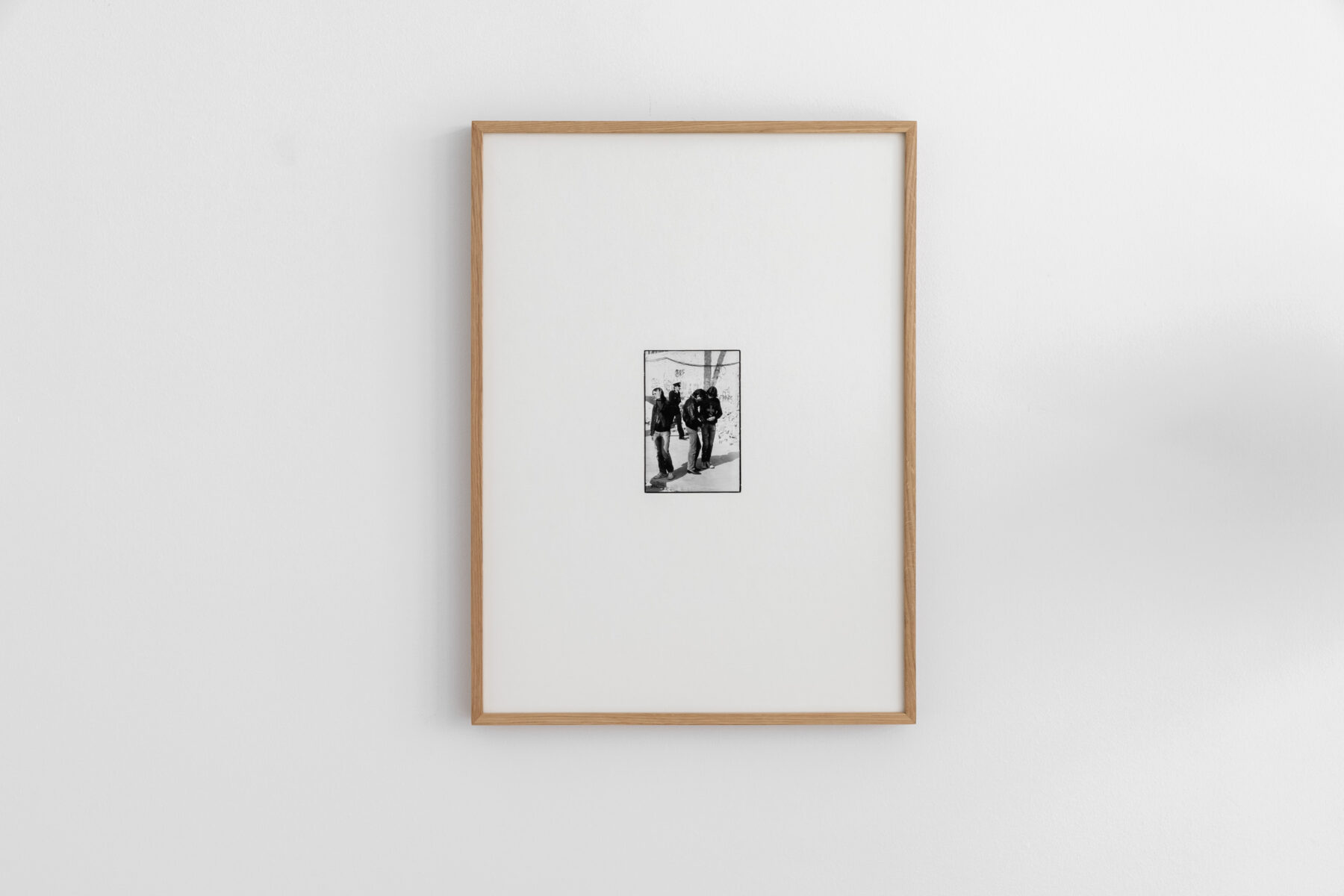George Tourkovasilis, Strange Switch
1 June – 24 Sept 2022
Melas Martinos, Pandrossou 50, 10555 Athens
Tuesday to Saturday, 12-6 pm
Melas Martinos (Strange Switch), Akwa Ibom (Spent) and Radio Athènes (The Night, Sleep) present a retrospective survey of the multifaceted work of photographer, writer, and poet George Tourkovasilis (1994-2021), composed in three chapters.
Text by George Tourkovasilis, published by Zygos in their May — June 1980 issue:
SELF-PRESENTATION
My studies in photography – “reading” and “writing” – began in France when I was already 25 years old. A late diagnosis of an “illness” that I seem to have developed young. There must be many who suffer from the same disease: being photographers without knowing it, tormented for a lifetime by a sensitive eye left unsatisfied, all because they never chanced to take a camera in their hands and gain consciousness of the power that hides be- hind their gaze. This kind of thing isn’t strange in Greece, where the language of photography is merely mumbled—we can’t really say that it’s articulated. I had to find myself in Paris to learn to read and write photographically!
Photography started as a Western invention and developed into a systematic visual language with both grammar and syntax chiefly in America. There’s no purely Greek photographic tradition to speak of all that took place in Greece was the application of linguistic lessons and the impact of aesthetic currents that first appeared abroad. We’re all primarily heirs to American photog- raphy, going back to the daguerreotype portraits of the 1800s, the pictorialism of 1980 – 1914, the straight photography of Paul Strand and Stieglitz, the pure photography of Ansel Adams and Weston, right through to the last currents of surrealism, contem- porary portraiture and reportage, and conceptual art. Instead of us Greeks ignoring this rich tradition in favor of a Balkan, nation- alistic mediocrity, we should study the history of photography; it is the only way we’ll be able to master all that is universal in this language, and wholly harness it as a medium in service of our own personal and national expression.
Through my ten-year-long study of Western photography, I will introduce a few exercises, or “studies,” taken from the recent exhibition at the Photography Center of Athens that surveyed
the first period of my work. On the street, in rooms, and even in the studio, I try to photograph people when they least expect it. These candid portraits are simultaneously a reportage, a tes- timony, and a record of a moment (a snapshot). And because they look absolutely balanced in space and time, they give the impression that the model had been posed, i.e. placed in the ap- propriate position with much care, like photographers used to do in the past. To achieve this, I search for spells of facial harmony in motion; the model moves or for a split second unwinds and relaxes—a moment of truth for the model and the photographer. Something akin to an electric spark binds them into a commu- nion that lasts as long as a flash’s burn. There are snapshots documenting carefree characters standing on the street or in- doors that seem contrived. Every right and balanced composition gives off the impression that someone placed things there; this happens because we are accustomed to the notion that reality is random and chaotic and unable to give birth to such harmonies. The “spontaneous” snapshots of Cartier-Bresson are images so full of visual cues, so articulately composed in their entirety, that they make it difficult for us to believe in the existence of a world so perfectly formed. On the other hand, Eugene Smith’s perfectly composed reportages are products of some direction.
The portraits I make are reportage, and the reportage are por- traits. I am so devoted to the human face that every day I devour figures in a crowd; with an exploratory gaze, I search for hidden mean- ings. Even when my subject is a group of people, I prefer to sacri- fice a full-body view to get a little closer to the details in a face (or a hand); to do this I use a lens – the Nikon 85mm – that is a little tele and a little normal, suitable for portraits and reportage. When I’m not photographing people in the street, magnetized by the information-brimming idiosyncrasies of faces of every age and gender, I try to capture the faces of boys that haven’t yet gone to the army—a subject wronged by photographers. Society seems more tolerant of boys at this age because, while the girls have been charged with playing the “female role” many years before them, the boys are only obliged to “manhood” after 20 when they enlist. Their anguish to escape this imminent molding is borne out in their attempts to “delay” the army and by extension their subordination to a social myth. Therefore, boys of “pre- military” age are freer and more authentic than their female friends of the same age; another manifestation of the well-known in- equality. The sway between feminine and masculine – preset as a strict dilemma, rather than a self-governed integration – is a fe- verish, dramatic mental state to be in, that endows teenage faces with bountiful meaning. Being exceptionally sensitive to signals these faces transmit, I attempt to interpret them in different ways. In these photographs, lonesome, pensive boys sit resting their faces on their palms (a variation on Rodin’s “Thinker”). At times, they bow their heads, conceal their faces with dark shades or hats, or turn their backs to the lens. The element: “face” – with
its luscious hair – forms a dialectic relationship with the element: “hand.”
Either hair covers the face leaving only hands to speak, or hands and face together assume a melancholic, meditative pose in some vacant room. In another expressionistic treatment of the same subject, I distort the face, removing its daily dress to express an opposite, equally real emotional state. The feeling is ecstatic, an explosion of unfathomable joy and optimism, the provocation of youth as it defies the grim prospect of coming of age, bestowing teenage-hood with a divine instant of eternity. Here the faces of boys are made in full motion, with rich ripples of hair caught in the wind. Avedon has given us such wonderful images of hair billowing around famous women’s heads – Lo- ren’s, Deneuve’s, Twiggy’s – and advertising, in general, has largely used such romantic photographs of women with untied hair rolling in the wind to advertise perfumes or shampoo; images that genealogically tie back to Art Nouveau, to the Renaissance of Botticelli and Michelangelo, to the paintings of Pompeii, and finally to ancient Greece. I simply invert the subject, and at the same time respond to the Avedon impulse, and make a comment on advertising photography. I use commercial mannerisms (hair blowing in the wind) to perform a twofold inversion. An inversion of subject: the heads of boys instead of girls. An inversion of substance: instead of a cold commercial message, an expression of real emotion.
Ultimately, advertising has authored no new poses or expres- sions; it has simply reconfirmed, stylized, and exploited some of those already around us that painting saw first. It has, though, perfected the expressive arsenal of photography to the point
that if you wanted to move further into any artistic inquiry using photography, you would have to pass through the linguistic con- quests of advertising photography (carried out under the pres- sures of financial competition with the help of sizable financial means.) I believe the advanced language of advertising photogra- phy, void of human meaning, must be taken up again by artists to express their ideas; in other words, they must help photography stand on its own two feet, returning to the art of photography its expressive vocabulary that advertising co-opted, evacuating it from any traces of life.
Translation: Aris Mochloulis
Warm thanks to Tasos Gkaintatzis, Victoria Fassianou, Marina Legaki, Natasa Koliou and Kyriakos Tsiflakos for entrusting us with works from their collections.
Τρία αφηγηματικά κεφάλαια από τους χώρους τέχνης Μελάς Μαρτίνος (Strange Switch), Akwa Ibom (Spent) και Radio Athènes (The Night, Sleep) συνθέτουν μία αναδρομική ματιά πάνω στο πολύπλευρο έργο του φωτογράφου, συγγραφέα και ποιητή Γιώργου Τουρκοβασίλη (1944-2021).
Κείμενο του Γιώργου Τουρκοβασίλη δημοσιευμένο από τον Ζυγό, τεύχος Μάιος – Ιούνιος 1980:
ΑΥΤΟΠΑΡΟΥΣΙΑΣΗ
Φωτογραφία – «γραφὴ» κι «ἀνάγνωση» – ἄρχισα νὰ μαθαίνω στὴ Γαλλία, ὅταν πιὰ ἤμουν 25 χρονῶν. Ἦταν ἡ καθυστερημένη διάγνωση μιᾶς «ἀρρώστειας», ποὺ τὴν εἶχα φαίνεται ἀπὸ μικρός. Θὰ ὑπάρχουν πολλοὶ ποὺ πάσχουν ἀπ ̓ τὴν ἴδια ἀρρώστεια: ποὺ εἶναι φωτογράφοι χωρὶς νὰ τὸ ξέρουν κι ὑποφέρουν μιὰ ζωὴ ἀπὸ μιὰ πολὺ εὐαίσθητη ματιὰ ποὺ μένει ἀνικανοποίητη, γιατὶ δὲν ἔτυχε νὰ πάρουν μηχανὴ στὰ χέρια γιὰ νὰ λάβουν συνείδηση τῆς δύναμης ποὺ κρύβει τὸ βλέμμα τους. Κάτι τέτοιο δὲν εἶναι περίεργο στὴν Ἑλλάδα, ὅπου ψελλίζεται — δὲν μποροῦμε νὰ ποῦμε μιλιέται — ἡ φωτογραφικὴ γλώσσα. Ἔπρεπε νὰ βρεθῶ στὸ Παρίσι γιὰ νὰ μάθω νὰ διαβάζω καὶ νὰ γράφω φωτογραφικά! Ἡ φωτογραφία ξεκίνησε ἀπὸ μιὰ δυτικὴ ἐφεύρεση κι ἀναπτύχθηκε σὲ ὀργανωμένη εἰκαστικὴ ἔκφραση, μὲ γραμματικὴ καὶ συντακτικό, κυρίως στὴν Ἀμερική. Δὲν μποροῦμε νὰ
μιλᾶμε γιὰ καθαρὰ ἑλληνικὴ φωτογραφικὴ παράδοση· ὅ,τι πραγματοποιήθηκε στὴν Ἑλλάδα ἦταν ἐφαρμογὴ γλωσσικῶν διδαγμάτων καὶ ἀντίκτυπος αἰσθητικῶν ρευμάτων ποὺ ἐμφανίστηκαν στὸ ἐξωτερικό. Εἴμαστε ὅλοι κληρονόμοι κυρίως τῆς ἀμερικανικῆς φωτογραφίας, ἀπ ̓ τὰ πορτραῖτα- νταγκεροτυπίες τοῦ περασμένου αἰώνα, τὸν πικτοριαλισμό τῶν ἐτῶν 1890 – 1914, τὴν ἄμεση φωτογραφία τοῦ Stieglitz καὶ τοῦ Paul Strand, τὴν καθαρὴ φωτογραφία τοῦ Weston καὶ τοῦ Ansel Adams μέχρι τὰ τελευταῖα ρεύματα τοῦ σουρεαλισμοῦ, τοῦ σύχρονου πορτραίτου καὶ ρεπορτάζ, τῆς ἀντιληπτικῆς (con- ceptual) τέχνης. Θἄπρεπε ἐμεῖς οἱ ῞Ελληνες, ἀντὶ νὰ ἀγνοοῦμε ὅλη αὐτὴ τὴν πλούσια παράδοση ἐν ὀνόματι μιᾶς βαλκανικῆς, ἐθνικόφρονης μετριότητας, νὰ μελετήσουμε καλὰ τὴν ἱστορία τῆς φωτογραφίας· μόνο ἔτσι σιγὰ-σιγὰ θὰ συγκρατήσουμε ὅ,τι πιὸ παγκόσμιο ἔχει αὐτὴ ἡ γλώσσα καὶ σὰν ἕνα ὁλοκληρωμένο πιὰ ἐκφραστικὸ ὄργανο θὰ τὴν θέσουμε στὴν ὑπηρεσία τῆς προσωπικῆς καὶ ἐθνικῆς μας ἔκφρασης.
Μέσα ἀπὸ τὴν δεκάχρονη μαθητεία μου στὴ δυτικὴ φωτογραφία θὰ σᾶς παρουσιάσω μερικὲς ἀσκήσεις, μερικὲς «σπουδές», παρμένες ἀπ ̓ τὴν πρόσφατη ἔκθεση στὸ Φωτογραφικὸ
Κέντρο Ἀθηνῶν, ποὺ συνόψιζε τὸ πρῶτο μέρος τῆς δουλειᾶς μου. Προσπαθῶ νὰ φωτογραφίζω ἀνθρώπους σὲ δρόμους, σὲ δωμάτια, ἀκόμα καὶ σὲ στούντιο, τὴ στιγμὴ ποὺ δὲ τὸ περιμένουν. Τὰ ἐξ ἀπροόπτου αὐτὰ πορτραῖτα εἶναι ταυτόχρονα καὶ ρεπορτάζ· μιὰ μαρτυρία, μιὰ καταγραφὴ τῆς στιγμῆς (στιγμιότυπα).
Κι ἐπειδὴ εἶναι ἄκρως ἰσορροπημένα στὸ χῶρο καὶ τὸν χρόνο δίνουν τὴν αἴσθηση ὅτι τὸ μοντέλο εἶναι στημένο, δηλαδὴ τοποθετημένο στὴν κατάλληλη στάση, ὕστερα ἀπὸ πολλὴ φροντίδα, ὅπως ἔκαναν οἱ παλιοὶ φωτογράφοι. Ἐν τούτοις ἀναζητῶ τὶς στιγμὲς ἰσορροπίας τοῦ προσώπου ἐν κινήσει, μέσα σὲ μιὰ συνεχῆ ροὴ στάσεων κι ἐκφράσεων· τὸ μοντέλο κινεῖται
ἤ ξεχνιέται καὶ ἠρεμεῖ γιὰ ἕνα κλάσμα τοῦ δευτερολέπτου· εἶναι ἡ στιγμὴ τῆς ἀλήθειας του καὶ τῆς ἀλήθειας τοῦ φωτογράφου. Κάτι σὰν ἠλεκτρικὸς σπινθήρας ἑνώνει τὰ δύο πρόσωπα σὲ μιὰ ἐπικοινωνία ποὺ διαρκεῖ ὅσο καὶ ἡ λάμψη τοῦ φλάς. Ὑπάρχουν στιγμιότυπα, μὲ πρόσωπα ἀμέριμνα νὰ στέκονται σ ̓ ἕνα δρόμο ἢ σ ̓ ἕνα ἐσωτερικὸ χῶρο, ποὺ μοιάζουν σκηνοθετημένα. Κάθε σωστὴ καὶ ἰσορροπημένη σύνθεση δίνει τὴν ἐντύπωση ὅτι κάποιος ἔβαλε τὰ πράγματα ἐκεῖ, ἐπειδὴ ἔχουμε συνηθίσει στὴν ἰδέα ὅτι ἡ πραγματικότητα εἶναι τυχαία καὶ χαοτικὴ καὶ δὲν μπορεῖ νὰ γεννήσει τέτοιες ἀρμονίες. Τὰ «τυχαῖα» στιγμιότυπα τοῦ Cartier-Bresson εἶναι εἰκόνες τόσο γεμάτες ὀπτικὰ σήματα, ἄρτια συνθεμένα σ ̓ ἕνα ὁλοκληρωμένο σύνολο, ποὺ δυσκολευόμαστε νὰ πιστέψουμε ὅτι τὰ πράγματα γύρω μας ὑπάρχουν ἀπὸ μόνα τους σ ̓ αὐτὴ τὴν τέλεια μορφή. Ἀπ ̓ τὴν ἄλλη, οἱ τέλειες ἐπίσης συνθέσεις στὰ ρεπορτὰζ τοῦ Eugene Smith εἶναι προϊὸν καὶ κάποιας σκηνοθεσίας.
Τὰ πορτραῖτα ποὺ κάνω εἶναι ρεπορτὰζ καὶ τὰ ρεπορτὰζ πορτραῖτα. Ἔχω τέτοια προσήλωση στὸ ἀνθρώπινο πρόσωπο, ποὺ κατατρώω καθημερινὰ μορφὲς μέσα στὸ πλῆθος, ἀναζητώντας μὲ ἐρευντητικὴ ματιὰ κρυφὲς πηγὲς νοήματος. Ἀκόμα κι ὅταν τὸ θέμα μου εἶναι σύνολο ἀτόμων, προτιμῶ νὰ θυσιάσω τὰ ὁλόσωμα πλάνα γιὰ νὰ φέρω τὸν φακὸ πιὸ κοντὰ στὶς λεπτομέρειες τοῦ προσώπου (ἢ τοῦ χεριοῦ), ἕνα φακό, τὸν 85άρη τῆς Nikon, ποὺ εἶναι λίγο τελέ, λίγο νορμάλ, κατάλληλος καί γιὰ πορτραῖτο καί γιὰ ρεπορτάζ. Ὅταν δὲν τυχαίνει νὰ φωτογραφίζω ἄτομα μέσα σὲ δρόμους, μαγνητισμένος ἀπὸ τὴν μεστὴ πληροφοριῶν ἰδιομορφία προσώπων πάσης ἡλικίας καὶ φύλου, προσπαθῶ νὰ καταγράψω πρόσωπα ἀγοριῶν ποὺ δὲν πῆγαν ἀκόμα στὸ στρατό· ἕνα θέμα ἀδικημένο ἀπ ̓ τοὺς φωτογράφους. Φαίνεται ὅτι ἡ κοινωνία εἶναι πιὸ ἀνεκτικὴ στ ̓ ἀγόρια αὐτῆς τῆς ἡλικίας, γιατὶ ἐνῶ τὰ κορίτσια ἀπὸ πολὺ νωρὶς ἔχουν ὑποχρεωθεῖ νὰ παίζουν τὸν «θηλυκὸ ρόλο», τὰ ἀγόρια θὰ ὑποχρεωθοῦν «νὰ γίνουν ἄντρες» μετὰ τὰ 20, ὅταν θὰ πᾶνε φαντάροι. Ἡ ἀγωνία τους νὰ ξεφύγουν ἀπ ̓ τὸ ἐπικείμενο καλούπωμα φαίνεται στὴν προσπάθειά τους «ν ̓ ἀναβάλουν» τὸν στρατό, ποὺ σημαίνει ν ̓ ἀναβάλουν τὴν ὑπαγωγή τους σ ̓ ἕναν κοινωνικὸ μύθο. Ἔτσι, τ ̓ ἀγόρια τῆς «προστρατιωτικῆς» ἠλικίας εἶναι πιὸ ἐλεύθερα, πιὸ αὐθεντικὰ ἀπὸ τὶς συντρόφισσές τους τῆς ἴδιας ἡλικίας, πρᾶγμα ποὺ ἀποτελεῖ μιὰ ἀκόμα ἐκδήλωση τῆς γνωστῆς ἀνισότητας. Ἡ ἀμφιταλάντευση ἀνάμεσα στὸ θηλυκὸ καὶ τὸ ἀρσενικό, μιὰ ἐπιλογὴ ποὺ ἔχει τεθεῖ σὰν αὐστηρὸ δίλημμα καὶ καθόλου σὰν ἐλευθερία συγκερασμοῦ τῶν δύο στοιχείων, εἶναι μιὰ
ψυχικὴ κατάσταση πυρετώδης καὶ δραματικὴ ποὺ προικίζει τὰ ἐφηβικὰ πρόσωπα μ ̓ ἕνα θησαυρὸ νοήματος. Ὄντας ἐξαιρετικὰ εὐαίσθητος στὰ σήματα ποὺ ἐκπέμπουν αὐτὰ τὰ πρόσωπα, ἐπιχειρῶ νὰ τὰ ἑρμηνεύσω μὲ πολλοὺς τρόπους.
Στὶς φωτογραφίες μου αὐτῆς τῆς ἑνότητας, μοναχικὰ ἀγόρια κάθονται σκεφτικά, ἀκουμπώντας τὸ πρόσωπο στὴν παλάμη (μιὰ παραλλαγὴ τοῦ «Σκεπτόμενου» τοῦ Rodin). Ἄλλοτε σκύβουν τὰ πρόσωπα ἢ τὰ κρύβουν μὲ μαῦρα γυαλιὰ ἢ καπέλλα ἢ στέκουν μὲ γυρισμένες τὶς πλάτες. Τὸ στοιχεῖο «πρόσωπο», μὲ τὰ πλούσια μαλλιὰ, ἔρχεται σὲ διαλεκτικὴ σχέση μὲ τὸ στοιχεῖο «χέρι». Εἴται τὰ μαλλιὰ σκεπάζουν ἐντελῶς τὸ πρόσωπο, ἀφήνοντας μόνο τὰ χέρια νὰ μιλᾶνε, εἴτε δημιουργοῦνται συμπλέγματα χεριῶν καὶ προσώπου σὲ μιὰ στάση μελαυχολίας καὶ βαθὺ διαλογισμοῦ, μέσα σ ̓ ἕνα ἄδειο δωμάτιο, ὅπου τὸ φῶς εἰσχωρεῖ λοξὰ ἀπ ̓τὸ μοναδικὸ παράθυρο μὲ δραματικὲς φωτοσκιάσεις. Σὲ μιὰν ἄλλη, ἐξπρεσιονιστική, ἀντιμετώπιση τοῦ θέματος ἀλλοιώνω τὸ πρόσωπο, ἀποσπώντας το ἀπ ̓ τὴν καθημερινή του ὲμφάνιση γιὰ νὰ ἐκφράσω μιὰν ἀντίθετη ψυχικὴ κατάσταση ἐξ ἴσου ἀληθινή. Εἶναι ἡ ἔκσταση, ἡ ἔκρηξη μιᾶς ἀπροσμέτρητης χαρᾶς κι αἰσιοδοξίας, ἡ πρόκληση τῆς νιότης ποὺ ἀψηφᾶ τὴ ζοφερὴ προοπτικὴ κάθε ἐνηλικίωσης, χαρίζοντας στὴν ἐφηβεία μιὰ θεϊκὴ στιγμὴ αἰωνιότητας. Ἐδῶ τὰ πρόσωπα τῶν ἀγοριῶν φωτογραφίζονται σὲ πλήρη κίνηση, μὲ τὰ μαλλιὰ συνεπαρμένα ἀπ ̓ τὸν ἀέρα σὲ πλούσιους κυματισμούς. Ὁ Avedon μᾶς ἔχει δώσει θαυμάσιες τέτοιες εἰκόνες μαλλιῶν ποὺ ἀνεμίζουν γύρω ἀπὸ διάσημα γυναικεῖα κεφάλια — τῆς Λῶρεν, τῆς Ντενέβ, τῆς Τουίγκυ — καὶ ἡ διαφήμιση ἔχει κατὰ κόρον χρησιμοποιήσει τέτοιες ρομαντικὲς φωτογραφίες γυναικῶν ποὺ μὲ τὰ μαλλιὰ ξέπλεκα στὸν ἀέρα διαφημίζουν κάποιο ἄρωμα ἢ σαμπουάν,
εἰκόνες ποὺ γενεαλογικὰ ἀνατρέχουν στὴν Αrt Nouveau, στὴν Ἀναγέννηση τοῦ Μποτιτσέλι καὶ τοῦ Μιχαὴλ Ἄγγελου, στὴ ζωγραφικὴ τῆς Πομπηίας κι ἐν τέλει τῆς ἀρχαίας Ἑλλάδας. Ἁπλῶς ἀντιστρέφω τὸ θέμα, ἐνῶ ταυτόχρονα «ἀπαντῶ» στὸ ἐρέθισμα Avedon, κάνοντας κι ἕνα σχόλιο πάνω στὴ διαφημιστικὴ φωτογραφία. Χρησιμοποιῶ δηλαδὴ τὴ μανιέρα ἑνὸς διαφημιστικοῦ ἐφφὲ (τὰ μαλλιὰ στὸν ἀέρα) γιὰ νὰ ἐπιχειρήσω μιὰ διπλῆ ἀντιστροφή. Ἀντιστροφὴ θέματος: κεφάλια ἀγοριῶν, ἀντὶ κοριτσιῶν. Ἀντιστροφὴ οὐσίας: ἀντὶ γιὰ ἕνα ψυχρὸ διαφημιστικὸ μήνυμα, ἡ ἔκφραση μιᾶς ψυχικῆς πραγματικότητας.
Τελικά, ἡ διαφήμιση δὲν ἔχει ἐφεύρει νέες στάσεις ἢ ἐκφράσεις προσώπου· ἔχει ἁπλῶς ἐπισημάνει, στυλιζάρει κι ἐκμεταλλευτεῖ ὡρισμένες ἀπ ̓ αὐτὲς ποὺ ὑπάρχουν γύρω μας καὶ ποὺ τὶς
ἔχει πρωτοϊδεῖ ἡ ζωγραφική. Ἀπὸ τὴν ἄλλη, ἔχει τελειοποιήσει τὸ ἐκφραστικὸ ὁπλοστάσιο τῆς φωτογραφίας σὲ σημεῖο ποὺ ἂν θέλεις νὰ προχωρήσεις βαθύτερα στὴν καλλιτεχνικὴ ἀναζήτηση νὰ εἶσαι ὑποχρεωμένος νὰ περάσεις ἀπὸ τὶς γλωσσικὲς κατακτήσεις τῆς διαφημιστικῆς φωτογραφίας,
ποὺ πραγματοποιήθηκαν κάτω ἀπὸ τὴν πίεση οἰκονομικοῦ ἀνταγωνισμοῦ καὶ μὲ τὴν συνδρομὴ μεγάλων οἰκονομικῶν μέσων. Πιστεύω πὼς τὴν προχωρημένη αὐτὴ γλώσσα τῆς διαφημιστικῆς εἰκόνας, ποὺ εἶναι κενὴ ἀνθρώπινου νοήματος, πρέπει νὰ τὴν ξαναπάρουν οἱ καλλιτέχνες φωτογράφοι στὰ χέρια τους καὶ νὰ τὴν χρησιμοποιήσουν γιὰ νὰ ἐκφράσουν τὶς ἰδέες τους· μ’ ἄλλα λόγια νὰ στήσουν τὴ φωτογραφικὴ γλώσσα στὰ πόδια της, ξαναδίνοντας στὴν τέχνη τῆς φωτογραφίας μιὰ πλούσια ἐκφραστικὴ φόρμα ποὺ τῆς ἀνήκει καὶ ποὺ τὴν οἰκειοποιήθηκε ἡ διαφήμιση, ἀδειάζοντάς την ἀπὸ τὸ ζωντανό της περιεχόμενο.
Θερμές ευχαριστίες στον Τάσο Γκαϊντατζή, την Νατάσα Κολιού, την Μαρίνα Λεγάκη, τον Κυριάκο Τσιφλάκο και την Βικτώρια Φασιανού για την ευγενική παραχώρηση έργων από τις συλλογές τους.
